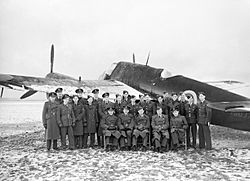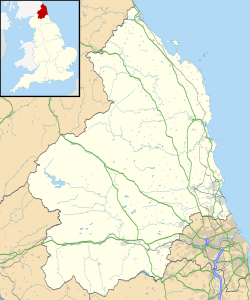RAF Acklington facts for kids
Royal Air Force Acklington, often called RAF Acklington, was an important air base in Northumberland, England. It's located about 3.2 miles (5.1 km) southwest of Amble and 8.8 miles (14.2 km) northeast of Morpeth. This airfield was first used by the Royal Flying Corps (RFC) and later by the Royal Air Force (RAF).
The base was open from 1916 to 1920, then reopened in 1938 and stayed active until 1972. After its military use, the land became home to two prisons. RAF Acklington played a key role during both the First World War and the Second World War.
Quick facts for kids RAF AcklingtonRAF Southfields RFC Southfields |
|||||||||||
|---|---|---|---|---|---|---|---|---|---|---|---|
| Acklington, Northumberland in England | |||||||||||

'B' flight, No. 409 Sqn RCAF with one of their Bristol Beaufighters in January 1942.
|
|||||||||||
|
Shown within Northumberland
|
|||||||||||
| Coordinates | 55°17′46″N 001°38′04″W / 55.29611°N 1.63444°W | ||||||||||
| Grid reference | NU230010 | ||||||||||
| Type | Satellite Station (1939-44) Forward Sector Station (1945-) |
||||||||||
| Code | AI | ||||||||||
| Site information | |||||||||||
| Owner | Ministry of Defence | ||||||||||
| Operator | Royal Flying Corps Royal Air Force |
||||||||||
| Controlled by | RAF Fighter Command * No. 13 Group RAF |
||||||||||
| Site history | |||||||||||
| Built | 1916 | ||||||||||
| In use | 1916–1920 1938–1975 |
||||||||||
| Battles/wars | European theatre of World War II Cold War |
||||||||||
| Airfield information | |||||||||||
| Elevation | 37 metres (121 ft) AMSL | ||||||||||
|
|||||||||||
Contents
A Look Back: RAF Acklington's Story
Early Days: World War I
During the First World War, Acklington was an airfield known as Royal Flying Corps Station Southfields. It was used by the RFC for training and defense.
Reopening for World War II
RAF Acklington reopened on April 1, 1938. It first served as a training center for air observers. In September 1939, as World War II began, it became a key base for RAF Fighter Command. This meant it was important for defending Britain's skies.
Famous Events and Squadrons
Many different squadrons were based at RAF Acklington during the war. These included:
On February 3, 1940, something historic happened. Three Hawker Hurricane fighters from 43 Squadron, led by Flight Lieutenant Peter Townsend, shot down a German Heinkel He 111 bomber. This was the first German aircraft to be shot down over English soil in World War II.
Another notable event involved test pilot Gerry Sayer. On October 21, 1942, he took off from Acklington in a Hawker Typhoon for a test flight. Sadly, his plane and another Typhoon disappeared, likely crashing over the bay.
RAF Acklington During the Battle of Britain
RAF Acklington played a vital role in the Battle of Britain in 1940. Several squadrons were based here, flying famous fighter planes like the Supermarine Spitfire and the Hawker Hurricane. They helped protect the UK from German air attacks.
Squadrons at Acklington during this time included:
- 72 Squadron (June to August 1940) with Spitfire Mk I.
- 79 Squadron (July to August 1940) with Hawker Hurricane Mk I.
- 32 Squadron (August to December 1940) with Hurricane Mk I.
- 610 Squadron (August to December 1940) with Spitfire Mk I.
More Squadrons (1940-1945)
After the Battle of Britain, many more squadrons used RAF Acklington. These included British, Polish, Dutch, and Belgian units. They flew various types of aircraft, continuing the defense effort.
Some of these squadrons were:
- 1, 25, 43, 56, 63, 74, 130, 141, 164, 167, 198, 219, 222, 263, 266, 278, 288, 289, 291, 309, 315, 316, 317, 322, 349, 350, 406, 409, 410, 504, 539 and 609.
After the War: Postwar Use
RAF Acklington continued to be an active base after World War II. It hosted many squadrons, flying different types of aircraft like Mustangs, Meteors, Javelins, Hunters, and Mosquitoes. These planes were used for various roles, including fighter defense.
Some of the squadrons stationed here postwar included:
- 18, 19, 23, 25, 29, 41, 54, 56, 64, 65, 66, 92, 74, 85, 91, 130, 140, 202, 219, 228, 247, 257, 263, 264, 266 and 275.
What's There Now: Current Use
RAF Acklington officially closed in 1975. The main part of the base was then turned into two prisons: Acklington and Castington. These prisons have since joined together and are now known as H.M.P. Northumberland.
Today, it's hard to recognize the old airfield. Much of the land has been used for open-pit coal mining, changing its appearance greatly.
See also
- List of former Royal Air Force stations


